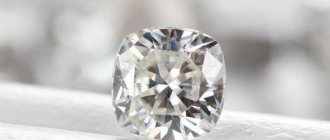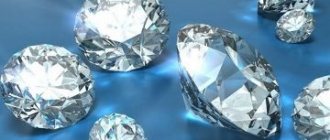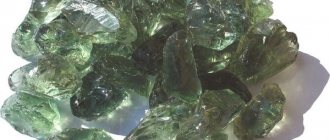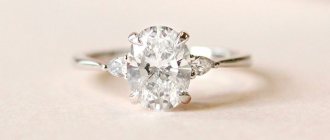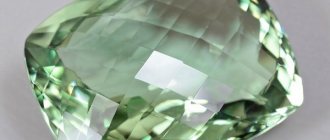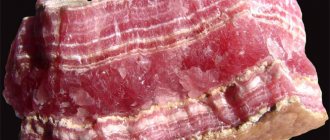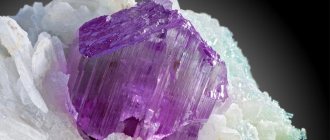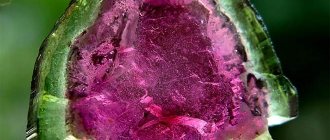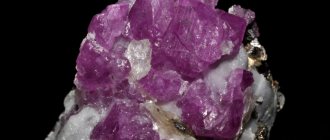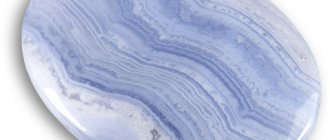Chemical and physical properties of moissanite
In terms of its composition, moissanite is silicon carbide. It seems so simple. However, the mineral has external characteristics and physical and chemical properties almost similar to diamonds. And this is its peculiarity and merit. Its reserves in nature are small, or, more simply, scanty. Therefore, they learned to grow stone synthetically, and this has been working well since the 1980s.
Moissanite is obtained from grown crystals of silicon carbide - SiC. At first, grayish-green stones and soft yellow ones were produced. Subsequently, samples of blue and even black shades appeared, and now synthetic stones can be of any color.
Moissanite surpasses even a diamond in radiance, brilliance and glow. The stone is often called an imitation of diamond, and the best one at that. But the properties of moissanite still differ from those of a diamond, although this can be proven in a laboratory equipped with special instruments. For example, moissanite has a higher dispersion than diamonds, and therefore literally plays and shimmers in its brilliance and glow. The dispersion of moissanite is 0.104, and that of diamonds is 0.044.
The hardness of the stone is less than that of diamond. On the Mohs scale, the hardness of moissanite is 9.25, while that of diamond is 10. The refractive index reaches 2.69, slightly higher than that of diamonds. Specific gravity is one of the indicators by which the difference between a diamond and moissanite is determined. Diamond – 3.52, moissanite – 3.25.
Story
Moissanite is the only gem in the world created artificially and then found in nature:
- The idea to create silicon carbide came to the chemist John Berzelius in 1824.
Jöns Jacob Berzelius
Seven decades later, Edward Acheson realized it by designing a furnace and patenting a method for producing a powdered substance under the brand name carborundum in 1893.
Edward Goodrich Acheson - Almost ten years later (1904), the first natural moissanites were discovered in fragments of a meteorite that fell in Arizona (US state). They were found by Ferdinand Moissan. He proved that these are not diamonds or their variety, but an independent mineral. At the suggestion of the famous American gemologist George Kunz, the find was dubbed moissanite.
- Even later, crystals began to be found on Earth, but in only a few cases.
Today, jewelry grade silicon carbide is produced artificially. Until 2015, the monopoly right to production belonged to the United States. Since 2015, several countries have been doing this. Russia and China have achieved particular success.
Origin
Moissanite is an artificial mineral that is close in quality to a natural diamond.
In recent years, it has been gaining the attention of jewelry manufacturers and the love of girls around the world! Few people know, but scientists were inspired to create artificial moissanite by natural moissanite. On our planet it is extremely rare, but in space there is plenty of this mineral. The whole secret is that, in fact, moissanite is just silicon mixed with carbon , but they must mix under such high pressure and high temperature that natural conditions sufficient for its birth exist only in space .
Comparison: moussanite on top, diamond on bottom
Natural moissanites fall to Earth along with fragments of meteorites , and are so small in size that they can only be examined under a microscope.
History says that the first traces of natural moissanite were discovered by the French chemist Ferdinand Henri Moissan while exploring the area where the Arizona meteorite fell in America. The scientific world recognized his discovery, and the mineral was named after Moissan.
Although there were doubts about the fairness of such a decision. It was rumored that in fact Moissan had found traces of silicon carbide - an artificial compound of sicilium and carbon, created by the Swedish Chemist Jacob Berzelius 70 years before Moissan's discovery.
Because of its excellent abrasive properties, silicon carbide was used to coat saws, including the one Moissan used during his discovery in Arizona. And real natural moissanite was discovered ten years after the Frenchman’s trip to America.
In any case, whoever found natural moissanite, its discovery remained unclaimed for another 150 years due to the lack of technical conditions for synthesizing silicon carbide. Only in 1982 did the American E.G. Achenson created a large artificial moissanite without any flaws. And this artificial mineral found its use in jewelry only in the late 90s.
Physico-chemical characteristics
From a chemical point of view, moissanite is silicon carbide with the simplest formula ( SiC ) and basic composition.
However, in colored specimens it is complicated by iron, titanium and other impurities.
| Color | dark green to blue, black |
| Stroke color | greenish gray |
| origin of name | In honor of Henri Moissan (1852-1907), French chemist. |
| Opening place | Canyon Diablo meteorite, Meteor Crater and vicinity, Winslow, Coconino Co., Arizona, USA |
| Opening year | 1893 |
| IMA status | approved |
| Chemical formula | a-SiC |
| Shine | glass semi-metallic |
| Transparency | transparent translucent translucent |
| Cleavage | imperfect |
| Kink | conchoidal |
| Hardness | 9,5 |
| Thermal properties | P. tr. doesn't melt |
| Strunz (8th edition) | 1/B.02-30 |
| Hey's CIM Ref. | 2.1 |
| Dana (7th edition) | 1.3.7.1 |
| Dana (8th edition) | 1.3.8.1 |
| Molecular weight | 40.10 |
| Point group | 6mm – Dihexagonal Pyramidal |
| Space group | P63 |
| Density (measured) | 3.218 – 3.22, average = 3.21 |
| Refractive indices | nω = 2.616 – 2.757 nε = 2.654 – 2.812 |
| Maximum birefringence | δ = 0.038 |
| Type | single-axis (+) |
| Optical relief | very tall |
| Selection form | Small tabular hexagonal plates. |
| Classes on taxonomy of the USSR | Nonmetals |
| IMA classes | Native elements |
| singonia | hexagonal |
Chemical and physical properties of moissanite
Carborundum (silicon carbide)
The chemical formula of the stone is SiC - silicon carbide. The hardness on the Mohs scale is 9.25, which is close to the standard diamond in this sense with its 10 units.
The color of natural moissanite is usually green or black, but in the case of a synthetic analogue, you can get any color or shade, although in 99% of cases colorless stones are used in jewelry to maximize the resemblance to natural diamonds. The refractive index reaches 2.69 (on average 0.25 higher than that of diamonds). The dispersion, which is responsible for the play of light, also exceeds the diamond indicator: for moissanite it is 0.104, and for diamonds it is 0.044.
However, let us remind you once again that we are talking about a synthetic analogue of a natural mineral. Natural moissanite is so rare that you will not find jewelry with this stone.
Advertising - Continued below
Where are moissanites found?
The main “deposit” of natural moissanites is meteorites that fell to Earth. But the grains extracted from there are no larger than 4 mm.
Moissanite single crystal ~1 mm in size
The stone is mined in kimberlite pipes, sometimes along with sapphire corundum. Rare, but found inside nugget diamonds.
Stone cost
Natural moissanite is a very rare and therefore expensive nugget. Synthesizing large stone crystals also makes them expensive.
Also read: Unakite is a unique relative of granite
However, the actual cost of the mineral will depend on its size, transparency and uniformity of color, color and the quality of the cut itself. Eg:
- a colorless artificial faceted stone of 1 carat (about 6.9 mm in diameter) will cost about $300;
- a green or blue stone of 1 carat is much cheaper - $240-250;
- 1 carat specimens in black, cognac or yellow – $220-230.
Of course, the cost of moissanite is lower than that of diamond, but small (up to 2 mm) stone chips will be more expensive than diamond chips of the same size.
Varieties
The newest classifications provide for the division into varieties of separately natural and synthetic materials.
Natural moissanite is divided by color:
- dark green;
- black.
The crystals are opaque, with dimensions of 0.5-4 mm.
There are more synthesized varieties:
- transparent, colorless (after cutting they can be said to be a moissanite diamond);
- yellow, “cognac”, blue, green, black crystals of jewelry quality;
- dark-colored specimens for technical use.
In laboratories you can grow moissanite jewelry crystals of all colors except red.
According to their dimensions, the grown raw materials are divided into powder, abrasive crumbs and crystals themselves (4-12 mm).
Production of synthetic moissanite
A jewelry crystal of natural origin is almost impossible. The deposits contain grains up to 4 mm in size. Known deposits can yield single gems. To solve the demand problem and fill the market with quality specimens, scientists have developed a method for making crystals in the laboratory. Colorless specimens and those colored in golden, yellow, green, and black shades are created. They weigh 0.01-14 carats. The smallest ones are used in paths and halos. In the descriptions of some earrings and rings you can see a mention of large moissanites - they are used to decorate the central part of the jewelry.
Commercial cultivation of stone used for jewelry was launched in the mid-90s of the last century. Charles and Colvard began production, but the monopoly did not last long. A decade later, the market was flooded with products from Russian, Indian, and Chinese laboratories. Now there are several large companies filling the international market with high quality samples. The leader is the American enterprise 3D-sorch, where the key technologists working with moissanite were Soviet emigrants. It is based on the Leili method developed by Tsvetkov and Tairov. Work begins at room temperature (silicon carbide sublimates into crystals) and continues when heated to 2400 degrees. A 200 gram crystal with excellent shine and hardness can be grown in just 15 hours.
An alternative production is the crystallization of liquid raw materials, distillation from steam into liquid and then into a solid. The second option requires silicon-containing methane.
Russian scientists have produced grey-green transparent crystals by sublimation under elevated pressure. For now, the method is used as an experimental one.
Jewelry is made in laboratories
How to distinguish from cubic zirconia
Cubic zirconia is an industrially produced mineral that has no natural analogue.
To distinguish it from moissanite, the thermal water content is checked - the indicator is much lower. Externally, cubic zirconia and gemstone are similar, so density and hardness are checked for diagnosis.
How to distinguish moissanite from diamond
It is very difficult to distinguish these breeds on your own. It is recommended to contact a specialist to evaluate the sample on the equipment.
Unusual valuable mineral
The gemologist will check:
- hardness (moissanite is slightly lower);
- purity (carborundum is higher due to its artificial origin);
- dispersion (carborundum has 2.5 times more);
- birefringence, presence of double ribs;
- heat resistance (moissanite changes color when heated at 65 degrees).
A laboratory stone is almost as good as a natural diamond.
Synthetic moissanite
The mineral moissanite of jewelry and technical types is synthesized in the laboratory. Industrial-scale production has been established since 1987.
Five synthesis methods have been developed:
- sintering of silica with carbon;
- silicon carbide sublimation;
- from methane;
- heating in a graphite crucible;
- crystallization from a liquid state.
With any method, an artificial material of the required standards is obtained - jewelry or industrial.
Moissanite and diamond
Although artificial stone is usually inferior to natural stone, transparent moissanite is an exception. It is no different from a diamond in appearance, only slightly inferior in hardness, and refracts light much better. Among artificially produced stones, the diamond analogue is the most expensive.
Price is one of the advantages of natural stone. A diamond is a good investment whose value increases over the years. True, it is very difficult to get the full price when selling jewelry; it takes a lot of time.
Laboratory stone is not inferior to natural stone
Jewelry market experts advise choosing a natural diamond if you need a small stone, and moissanite for those who need a large specimen. Jewelry with a laboratory gem is ideal for events with a large number of participants, where the product can be lost. If an accident occurs, the losses will be relatively small.
Areas of use
Moissanite is used in technology, by collectors and jewelers, depending on its origin, dimensions and other conditions:
- Natural crystals are not used - they are too small. They go to collectors - in meteorite blocks or earthly minerals.
- Jewelers work with synthetic moissanite. It is inserted into all types of jewelry.
Ring with synthetic moissanite
The most popular product is a ring with moissanite for all occasions (proposal, engagement, marriage, wedding anniversary, coming of age).
The widest scope of use is for technical moissanite:
- semiconductors, diodes, protective relays, transistors;
- optics (telescopes, other scientific instruments);
- abrasive tools;
- composite armor (coating of nuclear reactors, body armor, and other similar products);
- graphene synthesis;
- additive to foam concrete;
- heating elements.
Oil and gas workers use stone as a catalyst in the oxidation of hydrocarbons.
How to identify origin
Moissanite is both an imitation and an object of counterfeit.
You can independently distinguish the origin in several ways.
Diamond
Diamond and moissanite are considered “twins”: their formula and composition are identical.
A ring with a diamond
The following factors allow you to independently distinguish a diamond from moissanite:
- Examine through a magnifying glass or microscope under the light of a lamp of the growth zone. In grown stones, the growth lines look like ordered, rounded grooves; in diamonds, they are chaotic zigzags or sections.
- Moissanite floats in water, but diamond sinks.
- Look through the stone: moissanite will reveal twice the number of facets.
- A flame (even from a match) does not change the color of the diamond; moissanite turns green.
The easiest way is to take a sample with your hands. The fingerprint will only remain on the diamond.
cubic zirconia
Cubic zirconia is often offered under the guise of moissanite. It is cheaper, easily becomes cloudy, dark, and chips.
cubic zirconia
A sheet of white paper will help you distinguish between cubic zirconia and moissanite. A black dot is drawn on it and the sample is placed on it with the flat side. The pattern under the cubic zirconia will be clearly visible in all edges and will retain its dimensions.
How to care
With improper, irregular care, the gem loses its shine. To return it, they check for damage. You won’t be able to restore the crystal’s beauty on your own, but you can worsen the condition with unprofessional actions, so it’s better to immediately take the specimen to a jeweler. Using special equipment, he will check internal and external damage and process the jewelry with a laser. Microcracks are filled with special glue.
Store moissanite in a special box separately from other items so as not to scratch it.
If dust appears on the stone, wash the jewelry with soapy water, wipe it with alcohol, and with jewelry napkins made of non-woven material. It is forbidden to rub the object with force; use vinegar, potassium permanganate, or hydrogen peroxide for cleaning. If the contamination is severe, the item is taken to a jeweler for ultrasonic cleaning.
The stone requires maintenance
How to wear
A cut stone looks like a diamond and even better. The frame for it is made of precious metals - silver, platinum, gold of different shades.
When choosing products, the time of day, occasion, color matter:
- Pendant or stud earrings are suitable for the office.
- A bracelet, necklace, earrings with several stone inserts larger than a carat (6.5 mm) are worn for status or evening outings.
- Black moissanite is more suitable for men's assortment (cufflinks, ring, ring, tie clip). Miniature inserts in studs, pendants, and rings are organic in a woman's wardrobe.
During the day, it is not recommended to wear several jewelry with large stones or a large number of them at once. This is acceptable at evening receptions.
Moissanites are not combined with other stones (except cubic zirconia), especially semi-precious or ornamental ones.
Does moissanite change color when heated?
Moissanite has a very interesting property: if it is heated to 60 degrees, it begins to turn green. The more we heat it, the greener it becomes. This is due to its nature. It contains some substances that change color due to temperature.
We conducted an experiment and checked whether this is actually true. Because technology is improving, and modern moissanites have almost lost this property. This experiment is also interesting from a everyday point of view. If you have some jewelry with moissanite and you went to the sauna and forgot to take off the ring. What will happen to him? Will it turn green or not?
During the experiment, we heated cubic zirconia, moissanite and diamond in an oven at 275 degrees for 30 minutes and no color change occurred. This means that the myth that exists about the Moissanites has not been confirmed.
Experiment with heating moissanite
Price
The Russian market is saturated with moissanite products of all types, colors and sizes. Reputable companies and single craftsmen deal with stone.
Prices depend on the frame material, quantity and dimensions of inserts (thousand rubles):
- wedding ring (gold) – 24.2 – 46.6;
- bracelet (gold) – 62.9;
- pendant (silver) – 1.2.
The price of moissanite is measured in carats, just like a diamond. There is no clear figure for 1 carat, but an artificial stone can be bought 10-30 times cheaper than a diamond of comparable dimensions and condition.
Thus, the price range for American-made stones is $110 (0.5 carats) – $495 (1.5 carats). Diamond analogue – $2.5-20 thousand.
Is it worth buying moissanite?
You can absolutely safely buy moissanites. Old myths about ancient moissanites, which were made using old technology, have been dispelled. Moissanite does not change color, you can heat it completely calmly.
If you don't have a lot of money to spend on a diamond, moissanite is a great choice. You can also buy cubic zirconia, but cubic zirconia is very fragile. You must understand that if you wear it constantly, you will touch something with the jewelry, and a piece of the cubic zirconia will break off. In addition, cubic zirconia is scratched, there will be scratches on it, and this will be noticeable. After a while it will fade and will not look so beautiful. This will not happen with moissanite.
So if you don't have enough money to buy a diamond, buy moissanite, it looks just as great. They shine very brightly, sometimes even brighter than diamonds. You also need to keep in mind that you will not be able to resell it like a diamond. Also, moissanite will not increase in price the way a diamond does.
Over time, the price of diamonds, in relation to the price of the dollar, which is subject to natural inflation, like any currency, gradually increases. Diamonds have a secondary market; they are a liquid commodity. This will not happen with moissanites. But if you wear them to be beautiful, to make them shine, to highlight your individuality and style, then wear them with pleasure.
Therapeutic effect
Lithotherapists recognize the positive effect of the stone in diseases of the nervous system:
- Sparkling moissanite, by its very appearance, can relieve black melancholy, depression, or reduce aggression.
- Contemplation of a colorless stone or a stone of delicate shades (blue, green, pink) improves the functioning of the body as a whole.
- This is useful for women experiencing menopause.
For a healthy person, wearing a product with moissanite or contemplating the stone results in a surge of energy, improved memory, and relief from stress after work.
Medicinal properties
According to lithotherapists, contemplation of a colorless, blue or light green stone promotes healing:
- diseases of the central and peripheral nervous system;
- stress, depression;
- somatic diseases;
- menopausal syndrome;
- psychiatric illnesses.
Reference! The mineral does not help with diseases with pathological changes in tissue, such as fractures, strokes, ulcers, atherosclerosis, etc.
Also, when contemplating the stone, attention, memory, and brain activity improve, nervous tension goes away, energy and vitality increase.
Magic properties
The following magical properties of moissanite have been revealed:
- Attracts money (especially yellow or green).
- Strengthens the spirit, gives courage, raises self-esteem.
- Protects from unwanted outside influence.
- Helps to define a goal, control emotions, makes a speaker.
The magic of moissanite will support the owner in any difficult situation and streamline life.
A stone of any origin is suitable for magical purposes. But the synthetic one needs to be activated by exposing it to the sun before dawn.
Optical properties
Moissanite is a stone with a bright shine. The brilliance of the stone depends on the refraction of light rays inside the crystal: white light is split into its component colors. Moissanite has a refractive index of 2.56, higher than any other gemstone, including diamond.
Moissanite exhibits an impressive "play of light". The edges of the stone can shimmer with rainbow colors due to the light scattering effect. The dispersion of moissanite is 1.04, which is also higher than that of any other gemstone.
